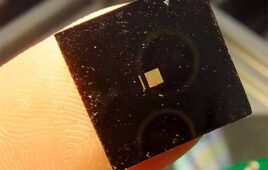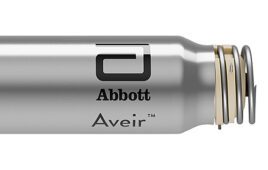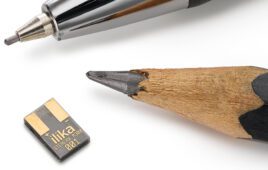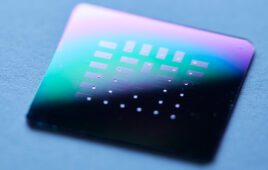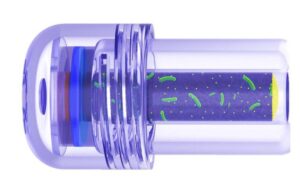
This biobattery could power ingestible cameras in the small intestine. [Image courtesy of Binghamton University]
They believe they can power devices in the hard-to-reach digestive organ, which winds around the human gut for an average of 22 feet.
“There are some regions in the small intestine that are not reachable, and that is why ingestible cameras have been developed to solve this issue,” professor Seokheun Choi said in a post on the university’s website. “They can do many things, such as imaging and physical sensing, even drug delivery. The problem is power. So far, the electronics are using primary batteries that have a finite energy budget and cannot function for the long term.”
Choi is a faculty member in the Department of Electrical and Computer Engineering at the Thomas J. Watson College of Engineering and Applied Science. Choi led a team of Ph.D. students, including Maryam Rezaie and Zahra Rafiee. Together, they published their findings in Advanced Energy Materials.
Their solution builds on Choi’s past research utilizing bacteria to create low levels of electricity that can power sensors and Wi-Fi connections. They say other options, like potentially harmful traditional batteries, are less viable. Wireless power transfer from outside the body is inefficient, they said, while temperature differences can’t harness thermal energy and intestinal movement is too slow for mechanical energy.
Instead, the biobattery uses microbial fuel cells with spore-forming Bacillus subtilis bacteria. They remain inert until they reach the small intestine, the researchers said.
The technology utilizes a pH-sensitive membrane that requires certain conditions to activate. It only works in the small intestine, based on the pH levels, as the stomach has very acidic pH, Choi said.
While some may not be keen on the idea of ingesting bacteria, Choi explained that bodies contain nontoxic microbes that help with digestion and other functions.
“We use these spores as a dormant, storable biocatalyst,” he said. “The spores can be germinated when the nutrients are available, and they can resume vegetative life and generate the power.”
Looking ahead, Choi and the team plan to improve the capsule-sized biobattery. For instance, it tends to take up to an hour to germinate completely once it reaches the small intestine. So they aim to make that faster.
The cell generates around 100 microwatts per square centimeter of power density. That represents enough for wireless transmission, but the researchers hope to make it 10 times more powerful.
Such batteries would also require animal and human testing, along with biocompatibility studies.
“I believe that our micro-fuel cell has a huge potential, but we have a long way to go,” Choi said.

